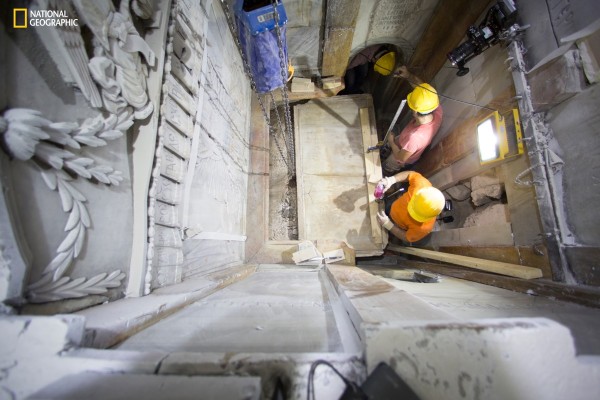By Gia, | October 28, 2016

The marble slab of the original burial bed of Jesus Christ.
Located underneath the Church of the Holy Sepulchre in the ancient city of Jerusalem, the tomb of Jesus Christ has finally been opened by archeologists hoping to restore the ancient burial place.
According to the National Geographic, the tomb was covered with marble slabs dating from at the year 1555 or from earlier centuries.
Like Us on Facebook
"The marble covering of the tomb has been pulled back, and we were surprised by the amount of fill material beneath it," said by Fredrik Hiebert, a partner archaeologist at the National Geographic Society for the restoration project. "It will be a long scientific analysis, but we will finally be able to see the original rock surface on which, according to tradition, the body of Christ was laid."
Among the National Geographic Society team are Greek researchers from the National Technical University of Athens in Greece under the command of Chief Scientific Supervisor Professor Antonia Moropoulou.
Hiebert told LiveScience that the Greek team was the first to spearhead the project and open the secluded ancient tomb. "It is pretty exceptional," he stated.
The body of Jesus Christ was laid to rest in a "burial bed" hewn from the side of a limestone cave after his crucifixion by the Romans around A.D 30 or 33. According to the Bible, Christ miraculously came back to life after three days. The resurrection of Jesus is the central tenet of Christian theology and part of the Nicene Creed.
The first Christian emperor of Rome, Constantine, built the Holy Edicule, a shrine located over the cave. The original top of the cave was originally open for pilgrims to gaze down upon the slab where Jesus was laid to rest after his death. The Holy Edicule was later reconstructed in the early 1800s after a fire.
With the burial bed exposed, analysis of the original rock chamber will give archeologists the opportunity to learn about the original form of the tomb and its evolution after Helena, the mother of Constantine, supposedly discovered it in 326 A.D.
"We are at the critical moment for rehabilitating the Edicule," Moropoulou said. "The techniques we're using to document this unique monument will enable the world to study our findings as if they themselves were in the tomb of Christ."
-
Use of Coronavirus Pandemic Drones Raises Privacy Concerns: Drones Spread Fear, Local Officials Say

-
Coronavirus Hampers The Delivery Of Lockheed Martin F-35 Stealth Fighters For 2020

-
Instagram Speeds Up Plans to Add Account Memorialization Feature Due to COVID-19 Deaths

-
NASA: Perseverance Plans to Bring 'Mars Rock' to Earth in 2031

-
600 Dead And 3,000 In The Hospital as Iranians Believed Drinking High-Concentrations of Alcohol Can Cure The Coronavirus

-
600 Dead And 3,000 In The Hospital as Iranians Believed Drinking High-Concentrations of Alcohol Can Cure The Coronavirus

-
COVID-19: Doctors, Nurses Use Virtual Reality to Learn New Skills in Treating Coronavirus Patients







